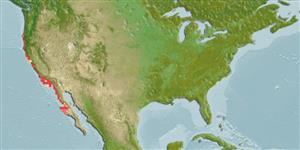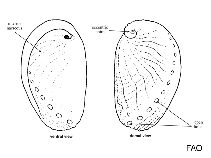Haliotis rufescens Swainson, 1822
Red abalone| Native range | All suitable habitat | Point map | Year 2050 |

|
| This map was computer-generated and has not yet been reviewed. |
| Haliotis rufescens AquaMaps Data sources: GBIF OBIS |
Mandar um arquivo com seu (sua) Fotos
Imagem do Google | No image available for this species;
drawing shows typical species in Haliotidae.
Imagem do Google | No image available for this species;
drawing shows typical species in Haliotidae.
Classification / Names Common names | Synonyms | CoL | ITIS | WoRMS
| Lepetellida | Haliotidae
Environment: milieu / climate zone / depth range / distribution range Ecologia
; intervalo de profundidade 0 - 24 m (Ref. 865). Subtropical; 8°C - 18°C (Ref. 106839); 43°N - 27°N, 125°W - 114°W (Ref. 106839)
Distribuição Países | Áreas FAO | Ecossistemas | Ocorrências | Introduções
Eastern Pacific: from Oregon, USA to Bahia Tortugas, Mexico. Introduced in the northeast Atlantic, southeast and western Pacific, Hawaii, and South Africa. Subtropical to temperate.
Length at first maturity / Tamanho / Peso / Idade
Maturity: Lm 4.0 range ? - ? cm Max length : 26.0 cm SHL macho/indeterminado; (Ref. 95344)
It moves across sand and gravel bottoms, from low intertidal to 24 meters in depth (Ref. 865). Predominantly found in or in near rocky macroalgal substrata (Ref. 106839). Feeds on algae (Ref. 105211).
Life cycle and mating behavior Maturidade | Reprodução | Desova | Ovos | Fecundidade | Larvas
Broadcast spawners. Life cycle: Embryos develop into planktonic trocophore larvae and later into juvenile veligers before becoming fully grown adults (Ref. 833).
Referência principal
Referências | Coordenador | Colaboradores
Bisby, F.A., M.A. Ruggiero, K.L. Wilson, M. Cachuela-Palacio, S.W. Kimani, Y.R. Roskov, A. Soulier-Perkins and J. van Hertum. 2005. (Ref. 19)
Status na Lista Vermelha da IUCN (Ref. 130435)
Criticamente em perigo (CR) (A2acde); Date assessed: 21 May 2021
Status no CITES (Ref. 108899)
Not Evaluated
CMS (Ref. 116361)
Not Evaluated
Perigo para os humanos
Uso pelos humanos
Pescarias: espécies comerciais
FAO - Aquacultura: produção; | FishSource | Sea Around Us
Ferramentas
Mais informação
Fontes da internet
BHL | BOLD Systems | CISTI | DiscoverLife | FAO(; publication : search) | Fishipedia | GenBank (genoma, nucleotídeo) | GloBI | Gomexsi | Google Books | Google Scholar | Google | PubMed | Árvore da vida | Wikipedia (Ir para, procura) | Registro zoológico
Estimates based on models
Nutrients: Calcium = 126 [75, 177] mg/100g; Iron = 4.79 [1.67, 7.92] mg/100g; Protein = 15.9 [14.8, 16.9] %; Omega3 = 0.331 [0.263, 0.400] g/100g; Selenium = 57.8 [48.5, 67.2] μg/100g; VitaminA = 0 μg/100g; Zinc = 1.97 [0.92, 3.02] mg/100g (wet weight).



